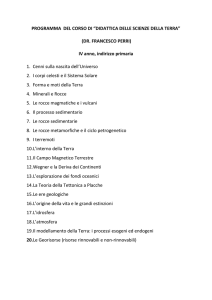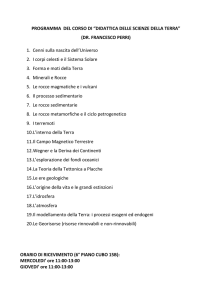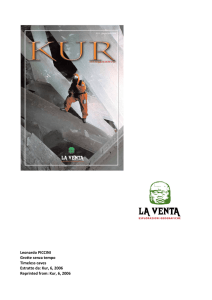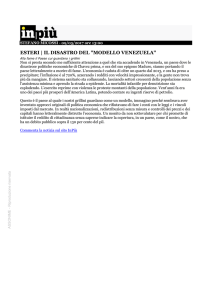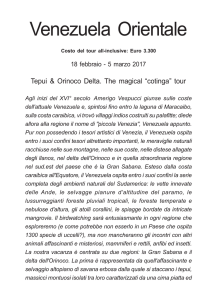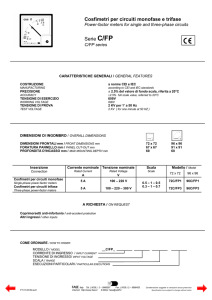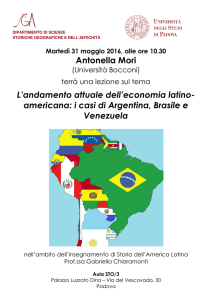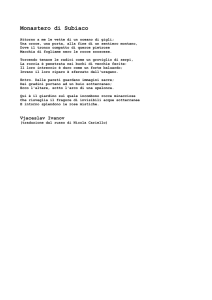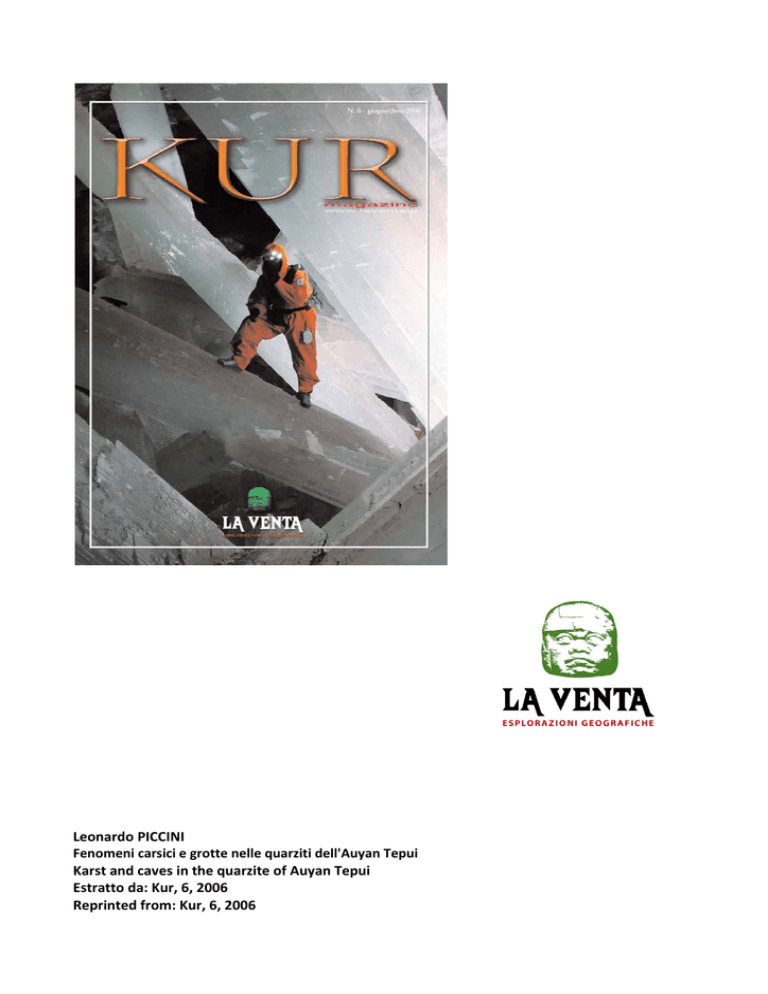
Leonardo PICCINI Fenomeni carsici e grotte nelle quarziti dell'Auyan Tepui Karst and caves in the quarzite of Auyan Tepui Estratto da: Kur, 6, 2006 Reprinted from: Kur, 6, 2006 Supplemento a / supplement to KUR magazine n. 6 - giugno/June 2006
Allegato tecnico - Technical notes
FENOMENI CARSICI E GROTTE NELLE
QUARZITI DELL’AUYÁN-TEPUI
(Gran Sabana – Venezuela)
Leonardo Piccini
KARST AND CAVES IN THE QUARTZITE OF
AUYÁN-TEPUI
(Gran Sabana, Venezuela)
Leonardo Piccini
1.Introduzione
1. Introduction
La Gran Sabana è una vasta area che si estende tra gli stati del
Venezuela, della Guayana e del Brasile, e che delimita a settentrione la foresta amazzonica.
Dalla pianura, solcata da un intricato sistema di fiumi che
costituiscono il bacino dell’Orinoco, si ergono alti massicci
rocciosi dalla tipica forma tabulare: sono i “tepui”, parola che
nella lingua delle tribù locali Pemon significa “montagna”.
Questi rilievi sono quel che rimane del lungo lavoro d’erosione, operato dai fiumi in oltre 200 milioni d’anni, a partire da
un vastissimo altopiano che alla fine del Triassico era tutt’uno
con gli altopiani dell’Africa centrale (nell’attuale Congo).
I tepui costituiscono alcuni dei più alti rilievi montuosi non
andini di tutto il continente sudamericano e molti di loro
sono tra le zone meno esplorate del nostro pianeta, soprattutto a causa della particolarità, comune alla maggior parte di
Gran Sabana is a vast area stretching between Venezuela,
Guyana and Brazil, marking the northern edge of the
Amazonian forest. Tall, rocky massifs with a typical plateau
shape rise from the plain, crisscrossed by a tangled river system.
These are the “tepui”, a word that in the language of the local
tribes means “mountain”.
These relieves represent what is left of the very long erosive
processes carried out by the rivers during more than 200 million
years, starting from a large highland that at the end of Triassic
was joined with Central Africa plateaus (corresponding to what
is now Congo). Tepui are amongst the tallest non-Andean relieves
in the whole South American continent and many of them are
amongst the least-explored areas in the whole planet. This is due
mostly to one of their peculiar features, found in most of them:
being surrounded by inaccessible vertical rock cliffs, several hundreds of meters tall. The best known amongst tepui is the
Roraima-tepui, up to 2810 meters high, located at the border
between Venezuela and Guyana; it was one of the first of Gran
Sabana massifs to be explored by speleologists.
On the other hand, the Auián-tepui can be found in the Bolivar
state, in the southern part of Venezuela. This massif is particularly renown due to the presence of the Salto Angel, the world’s
tallest waterfall, with its 942-meters drop. Such highland, more
than 700 km2 wide, stretches between 61° 00’ and 62° 30’ longitude West and between 5° 30’ and 6° 00’ latitude North. It
represents one of the largest and typical examples of table-mountain within the whole Gran Sabana. The average altitude is
around 2000 meters, its tallest peaks being up to 2800 meters, in
the western side (altitudes are approximated, as there are no topographical maps reporting definite elevations). The plateau slopes
down in a step-wise fashion towards NW, with a series of flat
areas that reach the western edge at an altitude of approximately 1500 meters. The highest of them lay more than 2500 meters
above sea level and represent the margins of an ancient erosion
surface, which is thought to have formed during the Mesozoic.
Dating such erosion palaeo-surface is quite difficult, because of
the complete lack of chronological clues. We do have, however,
some more information about the erosion surface located at an
altitude of about 1000 meters, that basically makes up for the
flat areas at the feet of the tepui. Such surface has been considered
to be Cretaceous-Jurassic in age, due to the presence, in certain
areas, of dated continental deposits. According to this hypothesis,
the landscape we see today would have been originated mostly
Localizzazione dell'area studiata: 1 - altopiano in quarziti (Formazione Matauì), 2 - rocce vulcaniche basiche;
(SAN = Sistema Auyán-tepui Noroeste).
Location map of studied area: 1 - quartzite plateau
(Matauì Formation), 2 - Basic vulcanic rock; (SAN =
Sistema Auyán-tepui Noroeste).
essi, di essere delimitati da inaccessibili pareti verticali alte
diverse centinaia di metri. Il più noto tra questi rilievi è il
Roraima-tepui, che raggiunge i 2810 m, situato al confine tra
Venezuela e Guayana, e tra i primi massicci della Gran Sabana
ad essere stato esplorato dagli speleologi.
L’Auián-tepui si trova invece nello stato di Bolivar, nella parte
meridionale del Venezuela, ed è noto soprattutto per la presenza del celeberrimo Salto Angel, la cascata più alta del
mondo, che presenta un salto di ben 972 m. Questo altopiano, vasto più di 700 km2, si estende tra i 61° 00’ e i 62° 30’
di longitudine W e tra i 5° 30’ e i 6° 00’ di latitudine N, costituendo uno dei più vasti e tipici esempi di montagna tabulare di tutta la Gran Sabana. L’altitudine media dell’altopiano è
intorno ai 2000 m, con le massime elevazioni intorno ai 2800
m situate nel settore orientale (le quote sono indicative non
esistendo carte topografiche quotate). L’altopiano digrada
progressivamente verso NW con una gradinata di superfici
pianeggianti situate a quote via via inferiori, sino a circa 1500
m di quota in corrispondenza dell’orlo occidentale.
Le spianate più elevate si trovano ad oltre 2500 m s.l.m. e rappresentano dei lembi residuali di un’antica superficie d’erosione, che si ritiene possa essersi formata durante il Mesozoico.
La datazione di questa paleosuperficie d’erosione è alquanto
problematica a causa della mancanza di qualsiasi indizio cronologico. Qualche elemento di datazione si ha invece per la
superficie d’erosione situata intorno ai 1000 m di quota , che
costituisce in pratica le zone pianeggianti poste ai piedi dei
tepui. Tale superficie è riferita al Cretaceo-Giurassico per la
presenza, in certe zone, di depositi continentali datati.
Secondo queste ipotesi, il paesaggio, come lo vediamo oggi, si
sarebbe modellato soprattutto tra il Giurassico e la fine del
Cretaceo, cioè in concomitanza delle fasi iniziali di separazione tra il continente americano e quello africano.
Le superfici d’erosione a quote intermedie, che spezzano la
continuità dei pianori sommitali, si sono originate probabilmente in epoche successive, con un lento processo di erosione influenzato dalle caratteristiche della roccia. In genere ogni
spianata è determinata dalla presenza di livelli più resistenti
all’erosione che spesso soggiacciono a strati a granulometria
più fine caratterizzati da una maggiore erodibilità.
2. Geologia
Tutta l’area della Gran Sabana fa parte di quello che i geologi
chiamano “Scudo della Guayana”, un settore di crosta continentale tra i più antichi affioranti sulla superficie terrestre,
costituito da rocce ignee o metamorfiche formatesi circa 3,5
miliardi di anni. A partire da non meno di due miliardi di
anni fa, sopra queste rocce cristalline iniziarono a depositarsi
i sedimenti limosi e sabbiosi portati dai fiumi che solcavano
un antico e primitivo continente. Tale processo durò per alcune centinaia di milioni di anni, in ambienti di pianure alluvionali, delta fluviali e di mare poco profondo, portando
all’accumulo di una coltre di sedimenti il cui spessore originario doveva raggiungere i 5 km. Nella parte inferiore, vicina
cioè al basamento cristallino, le rocce hanno grana fine e sono
costituite da siltiti e areniti stratificate e compatte per uno
spessore di circa 1000 m. Al di sopra di questi sedimenti fini
si trova un pacco, di circa 2000 m di spessore, di arenarie leggermente metamorfiche, cioè di rocce formate da sabbie compattate e ricementate, la cui principale caratteristica è di esse-
between the Jurassic and the end of Cretaceous, that is, at the initial phases of the separation between the African and American
continents.
The erosion surfaces found at intermediate altitudes, which
interrupt the continuity of the uppermost plateaus, probably originated at later times, with a slow erosion process that was controlled by the features of the rock itself. Generally speaking, each
flat area originates from the presence of layers that can resist erosion, often lying underneath other layers characterized by a finer
particle size distribution and by a higher erodibility.
2. Geology
All the Gran Sabana area is part of what geologists call the
“Guyana Shield”, one of the most ancient sections of the continental crust reaching the Earth surface, made of metamorphic or
igneous rocks that were created approximately 3.5 billion years
ago. Starting from at least two billion years ago, silt and sand
sediments began to deposit on top of these crystalline rocks, carried by the rivers that crossed an ancient and primitive continent.
Such process lasted for hundreds of millions of years, in flood
plains, river deltas and shallow seas, leading to the accumulation
of up to a 5 km-thick coat of sediments. In its lower part, i.e.,
near to the crystal base, rocks have a fine grain and consist of
mudstone and sandstone for a thickness of about 1000 meters.
Above, there is a pack (approximately 2000 meters thick) of
slightly metamorphic sandstones, that is, rocks made of compacted and re-cemented sands, whose main feature is to be made
almost exclusively of quartz granules; in other word, a quartzite.
Altogether, these ancient rocks are called Gruppo Roraima. The
different features of the rocks found in the lower part of the
Gruppo Roraima, compared to those found in the upper part,
explain the origin of the tableland shape of the mountain ranges
found in this zone. The main relieves, all the way from ground
level to the top, are made of extremely hard quartzite, that are
much harder to erode than the silty, clayey and sandy stones found
at their basis. Since their formation, these rocks endured very little tectonic deformations, that is, the tectonic forces that lead to
the formation of mountain ranges did not affect them. They were
simply lifted, sometimes by several kilometres, while maintaining
their horizontally layered structure.
The most relevant tectonic features occurring in the area are the
large fractures, aligned along preferential directions that fragment the plateaus into four-sided prisms. In the studied areas, the
main fractures (along which caves are also developed) are mostly
oriented in a NNW-SSE and NE-SW fashion.
3. Karst process
The shape of the rocks found on the flat areas of tepui, quite
peculiar from many points of view, were determined not only by
erosion but also by solution processes. The presence of solution
phenomena, affecting mostly the siliceous cement, led most
Authors to define many of the landforms as “pseudo-karst”. In
reality, such definition should be limited to those that imitate
actual karst forms under the geometrical point of view, but were
formed through completely different processes. In the case of
tepui, solution processes play a fundamental role in landscape
modelling and therefore it would be more appropriate to talk
about actual karst forms. Indeed, despite the very low solubility
of the siliceous-clastic rocks, there are remarkable similarities
re costituite quasi interamente da granuli di quarzo; si tratta
cioè di quarziti. Nell’insieme queste antiche rocce sedimentarie sono dette Gruppo Roraima.
Le differenti caratteristiche delle rocce della parte bassa del
Gruppo Roraima, rispetto a quelle della parte alta, sono all’origine della forma tabulare dei rilievi montuosi di questa
zona. I rilievi principali, a partire dal piede delle pareti sino
alla sommità del plateau, sono, infatti, costituiti dalle durissime rocce quarzitiche, assai più resistenti all’erosione delle
rocce siltose, argillose e arenacee della parte basale.
Queste rocce, dal momento della loro formazione, hanno
subito ben poche deformazioni tettoniche, non sono cioè
state soggette a spinte e pressioni tettoniche, quali quelle che
portano alla formazione delle catene montuose. Esse sono
state semplicemente sollevate, anche di diversi km, mantenendo un assetto a strati orizzontali.
Gli elementi tettonici più significativi presenti sono le grandi
fratture, allineate secondo direzioni preferenziali, che frammentano gli altopiani in prismi di forma quadrangolare. Nelle
aree studiate le fratture principali, lungo le quali si sviluppano anche le grotte, hanno direzione prevalente NNW-SSE e
NE-SW.
3. Il fenomeno carsico
Le forme con cui sono modellate le rocce che si ritrovano sulle
spianate dei tepui, per molti aspetti assolutamente peculiari,
sono dovute a processi non solo erosivi ma anche dissolutivi.
L’esistenza di fenomeni di dissoluzione, essenzialmente a scapito del cemento siliceo, ha portato molti autori a definire
“pseudocarsiche” molte delle forme presenti. In realtà l’uso
del termine pseudocarsico andrebbe limitato a quelle forme
che solo da un punto di vista geometrico imitano le forme
carsiche vere e proprie, ma che si sono formate in seguito a
processi completamente diversi.
between the landforms found in the tepui and those found in
limestone karst landscapes, similarities that are not just geometrical but also functional.
Although the mechanism of solution of siliceous cement is not
wholly clarified yet, the mid-low acidic pH (around 3.5-4, that
does not facilitate silica solution) and the low SiO2 found in the
waters suggest that time is a key player in this particular type of
karst phenomena. These tablelands have been experiencing, in
fact, a slow morphological evolution, in a state of almost complete
tectonic calm, for possibly 100-150 million years. This circumstance provides a very long time also for the development of smallsize forms.
The situation must have remained fairly stable also from a climatic point of view, as this part of the South American continent
has been part of the inter-tropical zone at least since the
Cretaceous. Finally, the modest slope of the top plateau lessens the
purely mechanical erosive effects of running waters, with the
exception of the beds of the torrents, while favouring at the same
time the processes of chemical degradation of the rocks.
4. Caves formation
The sima are certainly the most noticeable morphological aspect
found on the top plateaus of tepui. These are large cracks with an
enclosed perimeter, usually elongated in the same direction as the
fractures they originated from. For example, the Sima Aonda, the
largest sima known so far, is 350 meters deep for a length of
about 500 meters and a width of one hundred. Many sima are
deeper than 100 meters.
Sima are more frequently found towards the edges of the tepui
and represent the initial stage of the long lasting process of surface
modelling that leads to the formation of the erosion areas found
between the top surfaces and the valley level. Although they originate from tectonic fractures, their formation is mostly linked to
solution and erosion processes, coupled with collapses of under-
Profilo schematico del sistema Aonda (RAP = Resurgencia Ali Primera). Sketch profile of sistema Aonda (RAP =
Resurgencia Ali Primera).
Nel caso dei tepui, i processi di dissoluzione hanno un ruolo
determinante nel modellamento del paesaggio, e pertanto è
più corretto parlare di forme carsiche vere e proprie.
In effetti, a dispetto della bassissima solubilità delle rocce silico-clastiche, le somiglianze tra le forme presenti sui tepui e
quelle dei paesaggi carsici in rocce calcaree sono notevoli e
non sono solo geometriche ma anche funzionali.
Benché il meccanismo di dissoluzione del cemento siliceo
non sia ancora del tutto chiaro, i pH mediamente acidi
(intorno a 3,5-4), che quindi non facilitano la dissoluzione
della silice, e i bassi tenori di SiO2 riscontrati nelle acque da
noi analizzate, fanno supporre che per lo sviluppo di questo
particolare tipo di fenomeni carsici sia stato determinante il
fattore tempo. Questi altopiani, infatti, sono in lenta evoluzione morfologica, in uno stato di quasi assoluta quiescenza
tettonica, da forse 100, 150 milioni di anni. Questa circostanza mette a disposizione tempi molto lunghi anche per lo sviluppo di forme a piccola scala.
Anche da un punto di vista climatico la situazione deve essersi mantenuta relativamente stabile sino ad oggi, infatti, questa parte del continente sudamericano si trova all’interno della
fascia intertropicale almeno dal Cretaceo. Infine la bassa pendenza dei pianori sommitali attenua gli effetti erosivi puramente meccanici delle acque correnti, ad esclusione che negli
alvei dei torrenti, favorendo, al contempo, i processi di degradazione chimica delle rocce.
4. La formazione delle grotte
L’elemento morfologico più appariscente che si riscontra sui
plateau sommitali dei tepui è sicuramente rappresentato dalle
sima. Si tratta di grandi spaccature a perimetro chiuso, solitamente allungate in direzione delle fratture da cui si sono originate. Le loro dimensioni sono talvolta impressionanti. La
Sima Aonda, ad esempio, la maggiore tra quelle conosciute,
ha una profondità di 350 m per circa 500 di lunghezza e un
centinaio di larghezza. Molte sono quelle con profondità
superiori ai 100 m. Le sima sono più frequenti verso i margini dei tepui e rappresentano lo stadio iniziale del lungo processo di modellamento superficiale che porta alla formazione
dei ripiani di erosione posti tra le superfici sommitali e il
fondo valle. Anche se esse hanno origine da fratture di natura tettonica la loro formazione è legata soprattutto a processi
dissolutivi ed erosivi accompagnati da crolli di cavità sotterranee. Il processo può essere così riassunto. Nelle aree perimetrali dei plateau, in prossimità delle pareti, si hanno fenomeni di distensione delle masse rocciose, che portano all’apertura di numerose fratture. L’acqua che vi s’infiltra attacca il
cemento siliceo disgregando la roccia. Perché possa formarsi
una cavità occorre che la roccia alterata sia asportata dal basso,
e questo può succedere solo esiste una via sotterranea di evacuazione. In genere questa si forma in corrispondenza di livelli più erodibili. Molte grotte, in effetti, si estendono in profondità sino ad un’importante variazione litologica dove si ha
un piano di drenaggio orizzontale delle acque assorbite.
Nel tempo le spaccature tendono ad assumere dimensioni
sempre maggiori, soprattutto per crolli, e ad espandersi lungo
le discontinuità più importanti.
Un sima diventa a sua volta una zona di distensione della
massa rocciosa, e permette la formazione di nuove spaccature
“satellite”, sempre per distensione.
ground caves. The process could be summarized as follows: along
the perimeters of the plateaus, near the rock walls, there are phenomena of rock destressing that eventually lead to the formation
of many fractures. The water that penetrates inside them attacks
the siliceous cement and softens the rock. To form a cavity, the
altered rock must be removed from below, something that can
happen only in the presence of an underground drainage. In general, this happens within the most erodible layers. Indeed, many
caves deepen until they find a major lithologic change, where
there is a horizontal drainage for the absorbed waters.
In time, cracks tend to widen more and more, especially because
of collapses, and to expand along the most important discontinuities. A sima then becomes in itself an area of rock destressing,
thereby allowing the formation of new “satellite” cracks. The progressive merging of several cracks leads to the formation of deep
canyons, opened towards the valley, which then becomes bigger
and more branched by capturing more sima. In the end, large,
isolated quadrangular towers replace the original tableland. In
time, the latter ends up collapsing, thereby originating a chaotic
mass of colossal boulders. These are then progressively eroded,
L’unione progressiva di più spaccature porta alla formazione
di profondi canyon aperti verso valle che progressivamente si
ampliano e si ramificano catturando altre sima, sino a che dell’altipiano originario rimangono delle grosse torri quadrangolari isolate. Queste torri finiscono prima o poi per crollare
dando origine a caos di blocchi di dimensioni colossali. I
blocchi sono progressivamente erosi mettendo a nudo il ripiano che si è andato formando al di sotto di essi in corrispondenza di livelli più resistenti all’erosione e in cui ha già avuto
inizio un nuovo ciclo che porterà alla formazione di un altro
ripiano a quota inferiore.
5. Le grotte esplorate
Le grotte esplorate possono essere ricondotte a tre tipi diversi: grandi voragini di crollo, pozzi-frattura ed inghiottitoi.
Le prime si presentano con pozzi a cielo aperto di grandi
dimensioni (sima), profondi anche 300 m, al cui fondo si trovano grandi accumuli di frana. I pozzi-frattura, hanno dimensioni assai minore, in pianta, ma possono essere altrettanto
exposing the plateau that formed underneath, at the level of the
erosion-resistant layers. Here starts a new cycle that will eventually lead to the formation of another plateau at a lower altitude.
5. Explored caves
The explored caves belong to three different types: large collapse
chasms, fracture-shafts, and sinks. The former two are the sima,
large, open-ceiling shafts, up to 300-meters deep, with rockfall
debris at the bottom. Width-wise, fracture shafts are generally
smaller, but they can be just as deep. Usually they begin as elongated crevasses, a few meters wide and some tens of meters long.
Their size tends to increase with depth and usually they lead to
collapse cavities. Sinks are more rare and generally small-sized.
Amongst the cavities we explored during the 1993 and 1996
expeditions, the Sistema Auyán-tepui Noroeste is the most complex. The active entrance to the system (Sumidero del Rio
Pintado) leads to an underground canyon, several tens of meters
high and 2-4 meters wide, that ends up in a large hall created by
repeated collapses. These environments always have a quadrangular shape, and, having walls shaped along fracture surfaces and
profondi. In genere hanno
inizio in forma di crepacci, di
forma allungata, larghi pochi
metri e lunghi qualche decina. Le dimensioni tendono
ad aumentare in profondità e
solitamente immettono in
ambienti di crollo. Gli
inghiottitoi sono più rari e
hanno in genere dimensioni
modeste.
Tra le cavità esplorate nel
corso delle spedizioni del
1993 e del 1996, quella più
complessa è il Sistema
Auyán-tepui Noroeste.
L’ingresso attivo del sistema
(Sumidero del Rio Pintado)
immette su di un canyon sotterraneo, alto alcune decine
di metri e largo da due a
quattro, che si getta in una
grande sala, formata per crolli successivi. Questi ambienti
hanno sempre forma quadrangolare con pareti verticali impostate sulle superfici di
fratture e soffitti orizzontali
lungo i giunti di strato e
quindi si trovano in condizioni di elevata instabilità. Nelle
parti profonde del sistema si
raggiunge un collettore che
scorre in una forra alta sino a
50 m e larga mediamente
intorno a 4-5 m. Nella parte
bassa della forra, la presenza
di un livello di roccia più erodibile ha permesso lo sviluppo di nicchie laterali e piccole gallerie laterali connesse
con la forra principale.
L’altro grande sistema esplorato è quello della Sima Aonda. La Sima Aonda, di per sé, non
è propriamente classificabile come grotta, poiché le sue
dimensioni in pianta sono maggiori della profondità, che dal
bordo inferiore è di circa 280 m. Si tratta quindi di una forma
superficiale, di origine complessa, assimilabile per certi versi
ad una dolina di crollo. La vera grotta è quella che si apre
quasi al fondo della depressione, da noi denominata
Resurgencia Alì Primera, dal cui ingresso esce il collettore sotterraneo che drena tutta la piattaforma Aonda e che ha origine da un inghiottitoio posto circa 1,5 km a est. Il collettore è
stato seguito da valle per circa 1 km ed è stato raggiunto
anche dall’alto calandosi nella Sima del Bloque, una cavità
profonda 300 m, situata poche centinaia di metri a NE della
Sima Aonda.
Nella stessa zona esistono molte altre voragini, per lo più già
rilevate dai venezuelani negli anni ’80. Tra quelle esplorate da
noi ricordiamo la Sima “O corpuscolo” e la Sima “Fummifere
horizontal ceilings along bedding surfaces, are extremely unstable.
Deep inside the system one can reach a cave stream that flows
inside a gorge up to 50 meters high and 4-5 meters wide. In its
lower part, the presence of a layer made of more erodible rock
allowed the formation of side niches and small lateral tubes connected with the main gorge. The other large, explored system is
Sima Aonda’s system. Per se, the Sima Aonda chasm could not be
classified as a proper cave, as its horizontal length is larger than
its depth (the latter being 280 meters from the lower edge). It is
therefore a surficial structure, with a complex origin, that in some
aspects resembles a large sinkhole. The real cave, which we named
Resurgencia Alì Primera, is almost at the bottom of the depression; its entrance is the exit point of the underground catchment
that drains the whole Aonda platform and originates from a sinkhole located approximately 1.5 kilometres to the East. The stream
has been followed for about one kilometre upstream; it has also
been reached from above, descending inside Sima del Bloque, a
300-meter-deep cavity located a few hundreds of meters North-
Acque”, profonde rispettivamente 325 m e 335 m. In un settore vicino, nel 1993, è stata esplorata invece la Sima Churun,
profonda quasi 300 m, ove esistono concrete possibilità di
prosecuzione.
East of Sima Aonda.
In the same area there are many other large shafts, most of which
have already been mapped by the Venezuelans during the 1980s.
Amongst those we explored we can mention the Sima “O corpuscolo” and the Sima “Fummifere Acque”, 325 and 335
meters deep, respectively. In a nearby sector there is the
Sima Churun, almost 300 meters deep; it was explored
in 1993 and there is a real possibility of continuing the
exploration..
Bibliografia/bibliography
Bellomo R., S. Gori, I. Rigamonti, P. Tognini, G. Trezzi & P. Forti., “Il Sistema “Aonda Superior” dell'Auyántepui”. Resoconto della spedizione speleologica italiana “Venezuela 92”. El Guácharo, Soc. Venezolana Espeleol., 33,1994: 1-93.
Bernabei T. (Coordinatore), “Tepuy '93”. Progressione, C. G. E. Boegan, Trieste, 30, 1994: 1-120.
Bernabei T., M.Mecchia, P. Pezzolato, L. Piccini & E. Preziosi, “Tepuy '93; ancora Venezuela”. Speleologia, Soc. Spel. Ital., 29,1993: 823.
Briceño H.O. & Schubert C., “Geomorphology of the Gran Sabana, Guayana Shield, Southeastern Venezuela”. Geomorphology, 3,
1990: 125-141.
Doerr S. H., “Karst-like landforms and hydrology in quartzites of the Venezuelan Guyana shield: Pseudokarst or “real” karst?”. Z.
Geomorph. N. F., 43, 1,1999: 1-17.
Galán C., “Cavernas y formas de superficie en rocas siliceas precámbri¬cas del Grupo Roraima, Guayana, Venezuela”. Bol. Soc.
Venezolana Espeleol., 23, 1988: 1-12.
Galán C. & Lagarde J., “Morphologie et evolution des cavernes et formes superficielles dans les quartzites du Roraima (Venezuela)“.
Karstologia, 11-12: 49-59.
Ghosh S., “Geology of the Roraima Group and its implication”. Bol. Geol., Caracas, Pub. Esp., 10, (1985), 1988: 33-50.
Gori S., M. Inglese, P. Tognini, G. Trezzi, Rigamonti I., “Auyán-tepui, speleologia tropicale nelle quarziti”. Speleologia, Soc. Spel. Ital.,
28,1993: 23-33.
Mecchia M., Piccini L. & Preziosi E., “Idrogeologia dei sistemi Aonda, Auyántepuy Noroeste, Auyántepuy Norte 2”. Progressione, C.
G. E. Boegan, Trieste, 30, 1994: 27-33.
Piccini L., “Karst in siliceous rock: karts landforms and caves in the Auyán-tepui massif (Est. Bolívar, Venezuela)“. Int. Journ. Spel., 24
(Phys.), 1(4), 1995: 41-54.
Piccini L., Mecchia M. & Preziosi E., “Aspetti geologici e geomorfologici del settore nord-occidentale dell'Auyán-tepui (Est. Bolívar Venezuela)”. Progressione, C. G. E. Boegan, Trieste, 30, 1994: 14-26.
Piccini L., Mecchia M., “Hydrogeology and SiO2 geochemistry of the Aonda Cave System, Auyán-tepui, Bolivar, Venezuela”. Bol. Soc.
Venezolana Espel. (33), 19991-11.
Szczerban E. & F. Urbani F., “Carsos de Venezuela. Parte 4: Formas cársicas en areniscas precambricas del Territorio Federal Amazonas
y estado Bolívar”. Bol Soc.Venezolana Espeleol., 5, 1974: 27-54.
Urbani F., “Notas sobre el origin de las cavidades en rocas cuarcíferas precámbricas del Grupo Roraima, Venezuela”. Interciencia, Caracas,
11 (6), 1986: 298-300.
Urbani F., “Algunos comentarios sobre terminología kárstica aplicada a rocas silíceas”. Bol. Soc. Venezolana Espeleol., 24, 1991: 5-6.
Wray R. A. L., “Quartzite dissolution: karst or pseudokarst?”. Cave and Karst Science, 24(2), 1997: 81-86.


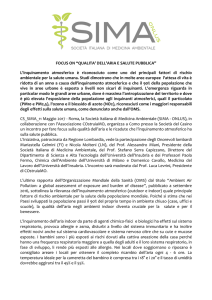
![Venezuela [modalità compatibilità]](http://s1.studylibit.com/store/data/001367128_1-8225119ce512119f10290e9887454499-300x300.png)

